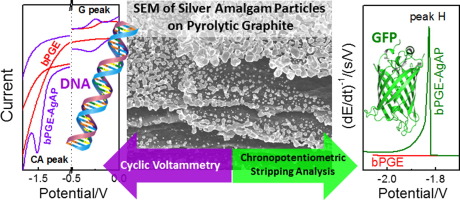当前位置:
X-MOL 学术
›
Bioelectrochemistry
›
论文详情
Our official English website, www.x-mol.net, welcomes your feedback! (Note: you will need to create a separate account there.)
Electrodeposited silver amalgam particles on pyrolytic graphite in (spectro)electrochemical detection of 4-nitrophenol, DNA and green fluorescent protein.
Bioelectrochemistry ( IF 5 ) Pub Date : 2019-12-03 , DOI: 10.1016/j.bioelechem.2019.107436 Peter Sebest 1 , Lukas Fojt 1 , Veronika Ostatna 1 , Miroslav Fojta 2 , Ales Danhel 1
Bioelectrochemistry ( IF 5 ) Pub Date : 2019-12-03 , DOI: 10.1016/j.bioelechem.2019.107436 Peter Sebest 1 , Lukas Fojt 1 , Veronika Ostatna 1 , Miroslav Fojta 2 , Ales Danhel 1
Affiliation

|
Catalytic properties and high adsorption affinity of nucleic acids and proteins to silver amalgam electrode surface make this kind of electrified interface perspective for bioanalytical and biomedical applications. For the first time, a basal-plane pyrolytic graphite electrode (bPGE) has been used as a substrate for electrodeposition of silver amalgam particles (AgAPs). Optimization of the resulting composition, surface morphology and electrochemical properties of the AgAPs was done by scanning electron microscopy with energy disperse X-ray spectroscopy, image processing software and voltammetric detection of electrochemically reducible model organic nitro compound, 4-nitrophenol. Spectro-electrochemical applicability of bPGE-AgAP has been demonstrated by electrolysis of 4-nitrophenol. Simultaneous UV-Vis-chronoamperometry provided information on the number of exchange electrons and the reduction rate constants. Preferential adsorption of the fluorescently labelled calf thymus DNA and the green fluorescent protein (GFP) on the surface of AgAPs was observed by fluorescence microscopy. In contrast to previously studied indium-tin oxide and vapour-deposited gold decorated by AgAPs, herein the presented bPGE-AgAP has provided sufficiently wide negative potential window allowing direct electroanalysis of non-labelled DNA and GFP using intrinsic electrochemical signals independently of the fluorescent labelling. The bPGE-AgAP can thus be expected to find application opportunities in protein electrochemistry, (bio)sensor development or in-situ spectro-electrochemical studies.
中文翻译:

在(光谱)电化学检测4-硝基苯酚,DNA和绿色荧光蛋白中,在热解石墨上电沉积银汞合金颗粒。
核酸和蛋白质对银汞合金电极表面的催化性能以及高吸附亲和力使这种带电界面成为生物分析和生物医学应用的理想选择。首次将基面热解石墨电极(bPGE)用作电沉积银汞合金颗粒(AgAP)的基材。AgAPs的组成,表面形态和电化学性能的优化是通过扫描电子显微镜,能量色散X射线光谱仪,图像处理软件以及电化学还原模型有机硝基化合物4-硝基苯酚的伏安法检测完成的。通过4-硝基苯酚的电解证明了bPGE-AgAP的光谱电化学适用性。同时进行紫外-可见-计时电流法可提供有关交换电子数和还原速率常数的信息。通过荧光显微镜观察到荧光标记的小牛胸腺DNA和绿色荧光蛋白(GFP)在AgAPs表面的优先吸附。与以前研究过的用AgAP装饰的氧化铟锡和气相沉积的金相反,本文介绍的bPGE-AgAP提供了足够宽的负电势窗口,允许使用固有的电化学信号直接对未标记的DNA和GFP进行电分析,而与荧光标记无关。因此,可以期望bPGE-AgAP在蛋白质电化学,(生物)传感器开发或原位光谱电化学研究中找到应用机会。
更新日期:2019-12-04
中文翻译:

在(光谱)电化学检测4-硝基苯酚,DNA和绿色荧光蛋白中,在热解石墨上电沉积银汞合金颗粒。
核酸和蛋白质对银汞合金电极表面的催化性能以及高吸附亲和力使这种带电界面成为生物分析和生物医学应用的理想选择。首次将基面热解石墨电极(bPGE)用作电沉积银汞合金颗粒(AgAP)的基材。AgAPs的组成,表面形态和电化学性能的优化是通过扫描电子显微镜,能量色散X射线光谱仪,图像处理软件以及电化学还原模型有机硝基化合物4-硝基苯酚的伏安法检测完成的。通过4-硝基苯酚的电解证明了bPGE-AgAP的光谱电化学适用性。同时进行紫外-可见-计时电流法可提供有关交换电子数和还原速率常数的信息。通过荧光显微镜观察到荧光标记的小牛胸腺DNA和绿色荧光蛋白(GFP)在AgAPs表面的优先吸附。与以前研究过的用AgAP装饰的氧化铟锡和气相沉积的金相反,本文介绍的bPGE-AgAP提供了足够宽的负电势窗口,允许使用固有的电化学信号直接对未标记的DNA和GFP进行电分析,而与荧光标记无关。因此,可以期望bPGE-AgAP在蛋白质电化学,(生物)传感器开发或原位光谱电化学研究中找到应用机会。



























 京公网安备 11010802027423号
京公网安备 11010802027423号